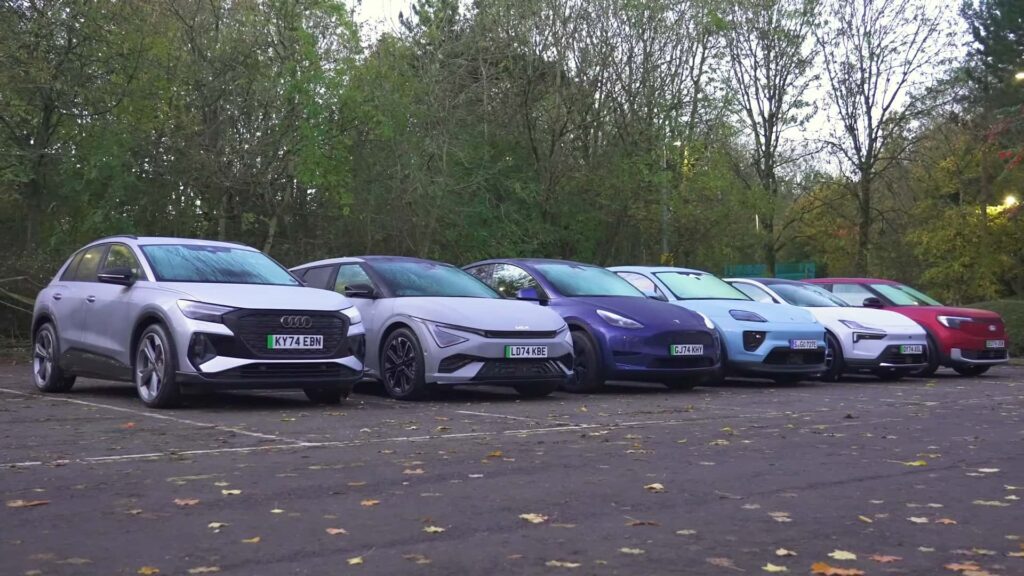CarWow recently conducted a fascinating test that pushed six electric crossovers to their limits. The test was conducted by Mat Watson and his team, who drove EVs from Audi, Porsche, Polestar, Kia, Ford, and Tesla until they ran out of juice. The results of the test were both surprising and enlightening.
The Polestar 4 emerged as the winner in terms of range but not efficiency. With a battery size of 94 kWh, it managed to cover 333 miles before giving up. However, its observed efficiency was 3.5 mi/kWh, which was lower compared to some of the other contenders.
In the real world, very few drivers would actually run their EV down to a 0% state of charge. However, these tests provide valuable insights into how different models perform under extreme conditions. The CarWow team charged each SUV up to 100% and drove at the posted speed limit with the climate control set to 68 degrees. They only slowed down to maximize range once the vehicle’s state of charge reached a critically low level.
The test results were as follows:
– Polestar 4: 94 kWh battery, 333 miles range, 3.5 mi/kWh efficiency, achieving 90% of its advertised range
– Porsche Macan: 95 kWh battery, 318 miles range, 3.5 mi/kWh efficiency, achieving 82% of its advertised range
– Tesla Model Y: 75 kWh battery, 294 miles range, 3.8 mi/kWh efficiency, achieving 79% of its advertised range
– Ford Explorer EV: 82 kWh battery, 291 miles range, 3.8 mi/kWh efficiency, achieving 78% of its advertised range
– Kia EV6: 80 kWh battery, 280 miles range, 3.4 mi/kWh efficiency, achieving 81% of its advertised range
– Audi Q4 E-Tron: 77.4 kWh battery, 268 miles range, 3.5 mi/kWh efficiency, achieving 79% of its advertised range
It’s worth noting that none of the vehicles matched their range ratings, which is not surprising given that the test was conducted at highway speeds. Additionally, the European-spec vehicles were tested according to Europe’s more generous WLTP standards, which differ from the EPA figures used in the United States.
Overall, the test provided valuable insights into the real-world range and efficiency of these electric crossovers, helping potential buyers make more informed decisions when choosing their next EV. The Polestar 4, a unique Chinese crossover with no rear window, has set a new standard in terms of range and efficiency. In a recent test, the Polestar 4 managed to travel an impressive 333 miles, achieving 90% of its WLTP range rating. This outstanding performance is attributed to its large 94-kilowatt-hour battery pack, which is one of the largest in its class.
Following closely behind is the Porsche Macan, which drove nearly as far as the Polestar 4. With a 95-kilowatt-hour battery pack, the Macan is equipped to deliver impressive range and efficiency. Despite being the oldest model in the lineup, the Tesla Model Y held its own by traveling nearly 300 miles with a smaller 75-kilowatt-hour battery pack.
Surprisingly, the Ford Explorer matched the Model Y in both range and efficiency, showcasing its capabilities in the electric SUV segment. This test highlights the importance of EV efficiency, as it can lead to cost savings, reduced energy consumption, and a lower carbon footprint in the long run.
The comparison between SUVs and sedans also demonstrates the superior efficiency of sedans, thanks to their lighter weight and aerodynamic designs. A previous test conducted by CarWow with six sedans showed significantly better results in terms of range and efficiency.
In this context, the Tesla Model 3 stands out with its 75-kilowatt-hour battery pack, achieving an impressive 352-mile range and an efficiency of 4.7 miles per kilowatt-hour. The Mercedes-Benz EQE takes it a step further by traveling a remarkable 357 miles on a single charge, showcasing the advancements in electric vehicle technology.
Overall, these range tests highlight the importance of efficiency in electric vehicles and how advancements in battery technology are pushing the boundaries of what is possible in terms of range and performance. As automakers continue to innovate and improve their electric offerings, consumers can expect even more impressive results in the future. As we continue to push the boundaries of electric vehicle (EV) technology, range testing becomes increasingly important. The ability of an EV to go the distance on a single charge is a key factor for consumers when deciding which model to purchase. Car manufacturers are constantly striving to improve the range of their EVs, but there are many variables that can affect the actual range achieved in real-world driving conditions.
One factor that can impact the range of an EV is the body style of the vehicle. Cars with a more aerodynamic design are generally more efficient, allowing them to travel further on a single charge. Of course, this may have had to do with the weather or road conditions on that particular day, but the body style surely has something to do with it too. SUVs and trucks, which are typically larger and less aerodynamic, may not be able to achieve the same range as a sleek sedan or hatchback.
At InsideEVs, we are constantly testing the range of new EV models to provide consumers with accurate information about how far they can expect to go on a single charge. We recently tested the Rivian R1T, which is touted as having one of the longest ranges of any EV on the market. Our road-tripping test put this claim to the test, and the results were impressive. The Rivian R1T lived up to its reputation, proving that it is a capable long-distance traveler.
But our testing doesn’t stop there. We want to hear from you, our readers, about which cars you would like to see us range-test in the future. Are there any specific models that you are curious about? Any other tests you want us to conduct? Let us know in the comments below so we can continue to provide you with the information you need to make informed decisions about EVs.
Do you have a tip or insider information about the EV world? Feel free to contact the author, Tim Levin, at tim.levin@insideevs.com. Your input could help shape the future of our testing and reporting on all things EV.
In conclusion, range testing is a crucial aspect of evaluating the performance of electric vehicles. Factors such as body style, weather conditions, and road conditions can all impact the range of an EV. By conducting rigorous tests and providing accurate information to consumers, we can help drive the adoption of EV technology and support the transition to a more sustainable future.

